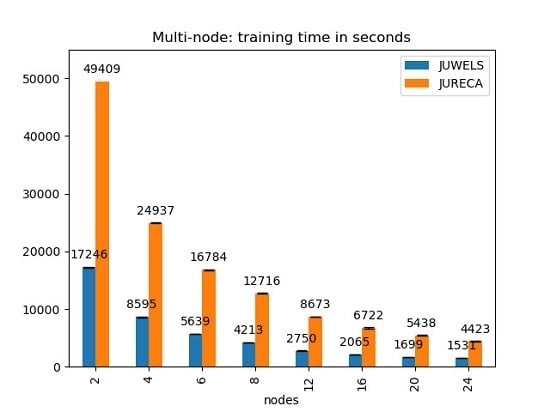Comparison of Regional Simulation of Biospheric CO2 Flux from the Updated Version of CarbonTracker Asia with FLUXCOM and Other Inversions over Asia
Abstract
:1. Introduction
- What is the consistency and discrepancy of NEE flux of CTA2017 compared to MACC, CAMS, Jena CarbonScope, and FLUXCOM in terms of monthly, seasonal, and annual time scales?
- How consistent are the CTA2017 estimates of spatial diurnal averaged NEE flux in comparison with the FLUXCOM?
- What is the impact of the nesting approach on the strength of the carbon sink and source over Asia at seasonal and annual timescales?
2. Materials and Methods
2.1. CarbonTracker CO2 Flux
2.2. FLUXCOM Data
2.3. Other Atmospheric Inversion Data
2.4. Land Cover Data
2.5. Methods
3. Results and Discussion
3.1. Assessment of Consistency and Discrepancy of Spatial and Domain Aggregated NEE Flux
3.2. Comparisons of Temporal Distributions of Aggregated Mean NEE Flux across Biomes
3.3. Diurnal Averaged NEE Flux in Summer
3.4. Spatio-Temporal Distribution of NEE Flux
4. Conclusions
Author Contributions
Funding
Acknowledgments
Conflicts of Interest
References
- Le Quéré, C.; Andrew, R.M.; Canadell, J.G.; Sitch, S.; Korsbakken, J.I.; Peters, G.P.; Manning, A.C.; Boden, T.A.; Tans, P.P.; Houghton, R.A.; et al. Global Carbon Budget 2016. Earth Syst. Sci. Data 2016, 8, 605–649. [Google Scholar] [CrossRef] [Green Version]
- Le Quéré, C.; Andrew, R.M.; Friedlingstein, P.; Sitch, S.; Pongratz, J.; Manning, A.C.; Korsbakken, J.I.; Peters, G.P.; Canadell, J.G.; Jackson, R.B.; et al. Global Carbon Budget 2017. Earth Syst. Sci. Data 2018, 10, 405–448. [Google Scholar] [CrossRef] [Green Version]
- Labzovskii, L.D.; Mak, H.W.L.; Kenea, S.T.; Rhee, J.-S.; Lashkari, A.; Li, S.; Goo, T.-Y.; Oh, Y.-S.; Byun, Y.-H. What can we learn about effectiveness of carbon reduction policies from interannual variability of fossil fuel CO2 emissions in East Asia? Environ. Sci. Policy 2019, 96, 132–140. [Google Scholar] [CrossRef]
- Zhang, H.F.; Chen, B.Z.; van der Laan-Luijkx, I.T.; Machida, T.; Matsueda, H.; Sawa, Y.; Fukuyama, Y.; Langenfelds, R.; van der Schoot, M.; Xu, G.; et al. Estimating Asian terrestrial carbon fluxes from contrail aircraft and surface CO2 observations for the period 2006–2010. Atmos. Chem. Phys. 2014, 14, 5807–5824. [Google Scholar] [CrossRef] [Green Version]
- Friedlingstein, P.; Meinshausen, M.; Arora, V.K.; Jones, C.D.; Anav, A.; Liddicoat, S.K.; Knutti, R. Uncertainties in CMIP5 Climate Projections due to Carbon Cycle Feedbacks. J. Clim. 2014, 27, 511–526. [Google Scholar] [CrossRef] [Green Version]
- Francey, R.J.; Trudinger, C.M.; van der Schoot, M.; Law, R.M.; Krummel, P.B.; Langenfelds, R.L.; Steele, L.P.; Allison, C.E.; Stavert, A.R.; Andres, R.J. Atmospheric verification of anthropogenic CO2 emission trends. Nat. Clim. Chang. 2013, 3, 520–524. [Google Scholar] [CrossRef]
- Patra, P.K.; Canadell, J.G.; Houghton, R.A.; Piao, S.L.; Oh, N.-H.; Ciais, P.; Manjunath, K.R.; Chhabra, A.; Wang, T.; Bhattacharya, T.; et al. The carbon budget of South Asia. Biogeosciences 2013, 10, 513–527. [Google Scholar] [CrossRef] [Green Version]
- Thompson, R.L.; Patra, P.K.; Chevallier, F.; Maksyutov, S.; Law, R.M.; Ziehn, T.; Van der Laan-Luijkx, I.T.; Peters, W.; Ganshin, A.; Zhuravlev, R.; et al. Top-down assessment of the Asian carbon budget since the mid 1990s. Nat. Commun. 2016, 7. [Google Scholar] [CrossRef] [Green Version]
- Gurney, K.R.; Law, R.M.; Denning, A.S.; Rayner, P.J.; Baker, D.; Bousquet, P.; Bruhwiler, L.; Chen, Y.-H.; Ciais, P.; Fan, S.; et al. Towards robust regional estimates of CO2 sources and sinks using atmospheric transport models. Nature 2002, 415, 626–630. [Google Scholar] [CrossRef] [Green Version]
- Gurney, K.R.; Law, R.M.; Denning, A.S.; Rayner, P.J.; Baker, D.; Bousquet, P.; Bruhwiler, L.; Chen, Y.-H.; Ciais, P.; Fan, S.; et al. TransCom 3 inversion intercomparison:1. Annual mean control results and sensitivity to transport and prior flux information. Tellus 2003, 55, 555–579. [Google Scholar] [CrossRef] [Green Version]
- Vogel, F.R.; Ishizawa, M.; Chan, E.; Chan, D.; Hammer, S.; Levin, I.; Worthy, D.E.J. Regional non-CO2 greenhouse gas fluxes inferred from atmospheric measurements in Ontario, Canada. J. Integr. Environ. Sci. 2012, 9, 41–55. [Google Scholar] [CrossRef]
- Miller, J.B.; Montzka, S.A.; Nehrkorn, T.; Sweeney, C. Anthropogenic emissions of methane in the United States. Proc. Natl. Acad. Sci. USA 2013, 110, 20018–20022. [Google Scholar] [CrossRef] [PubMed] [Green Version]
- Basu, S.; Baker, D.F.; Chevallier, F.; Patra, P.K.; Liu, J.; Miller, J.B. The impact of transport model differences on CO2 surface flux estimates from OCO-2 retrievals of column average CO2. Atmos. Chem. Phys. 2018, 18, 7189–7215. [Google Scholar] [CrossRef] [Green Version]
- Locatelli, R.; Bousquet, P.; Chevallier, F.; Fortems-Cheney, A.; Szopa, S.; Saunois, M.; Agustí-Panareda, A.; Bergmann, D.; Bian, H.; Cameron-Smith, P.; et al. Impact of transport model errors on the global and regional methane emissions estimated by inverse modelling. Atmos. Chem. Phys. 2013, 13, 9917–9937. [Google Scholar] [CrossRef] [Green Version]
- Kenea, S.T.; Oh, Y.-S.; Rhee, J.-S.; Goo, T.-Y.; Byun, Y.-H.; Li, S.; Labzovskii, L.D.; Lee, H.; Banks, R.F. Evaluation of simulated CO2 concentrations from the CarbonTracker-Asia model using in-situ observations over East Asia for 2009–2013. Adv. Atmos. Sci. 2019, 36, 603–613. [Google Scholar] [CrossRef]
- Peters, W.; Jacobson, A.R.; Sweeney, C.; Andrews, A.E.; Conway, T.J.; Masarie, K.; Miller, J.B.; Bruhwiler, L.M.P.; Pétron, G.; Hirsch, A.I.; et al. Atmospheric perspective on North American carbon dioxide exchange: CarbonTracker. Proc. Natl. Acad. Sci. USA 2007, 104, 18925–18930. [Google Scholar] [CrossRef] [Green Version]
- Chevallier, F.; Fisher, M.; Peylin, P.; Serrar, S.; Bousquet, P.; Bréon, F.-M.; Chédin, A.; Ciais, P. Inferring CO2 sources and sinks from satellite observations: Method and application to TOVS data. J. Geophys. Res. Atmos. 2005, 110, D24309. [Google Scholar] [CrossRef]
- Chevallier, F.; Ciais, P.; Conway, T.J.; Aalto, T.; Anderson, B.E.; Bousquet, P.; Brunke, E.G.; Ciattaglia, L.; Esaki, Y.; Fröhlich, M.; et al. CO2 surface fluxes at grid point scale estimated from a global 21 year reanalysis of atmospheric measurements. J. Geophys. Res. Atmos. 2010, 115, D21307. [Google Scholar] [CrossRef] [Green Version]
- Rödenbeck, C.; Houweling, S.; Gloor, M.; Heimann, M. CO2 flux history 1982–2001 inferred from atmospheric data using a global inversion of atmospheric transport. Atmos Chem. Phys. 2003, 3, 1919–1964. [Google Scholar] [CrossRef] [Green Version]
- Rödenbeck, C. Estimating CO2 Sources and Sinks from Atmospheric Mixing Ratio Measurements Using a Global Inversion of Atmospheric Transport; Max Planck Institute for Biogeochemistry: Jena, Germany, 2005. [Google Scholar]
- Bodesheim, P.; Jung, M.; Gans, F.; Mahecha, M.D.; Reichstein, M. Upscaled Diurnal Cycles of Carbon and Energy Fluxes; Max Planck Institute for Biogeochemistry: Jena, Germany, 2017. [Google Scholar] [CrossRef]
- Peters, W.; Krol, M.C.; van der Werf, G.R.; Houweling, S.; Jones, C.D.; Hughes, J.; Schaefer, K.; Masarie, K.A.; Jacobson, A.R.; Miller, J.B.; et al. Seven years of recent European net terrestrial carbon dioxide exchange constrained by atmospheric observations. Glob. Chang. Biol. 2010, 16, 1317–1337. [Google Scholar] [CrossRef]
- Krol, M.; Houweling, S.; Bregman, B.; van den Broek, M.; Segers, A.; van Velthoven, P.; Peters, W.; Dentener, F.; Bergamaschi, P. The two-way nested global chemistry-transport zoom model TM5: Algorithm and applications. Atmos. Chem. Phys. 2005, 5, 417–432. [Google Scholar] [CrossRef] [Green Version]
- Kaminski, T.; Rayner, P.J.; Heimann, M.; Enting, I.G. On aggregation errors in atmospheric transport inversions. J. Geophys. Res. 2001, 106, 4703–4715. [Google Scholar] [CrossRef] [Green Version]
- Dee, D.P.; Uppala, S.M.; Simmons, A.J.; Berrisford, P.; Poli, P.; Kobayashi, S.; Andrae, U.; Balmaseda, M.A.; Balsamo, G.; Bauer, P.; et al. The ERA-Interim reanalysis: Configuration and performance of the data assimilation system. Q. J. R. Meteorol. Soc. 2011, 137, 553–597. [Google Scholar] [CrossRef]
- Tramontana, G.; Jung, M.; Schwalm, C.R.; Ichii, K.; Camps-Valls, G.; Ráduly, B.; Reichstein, M.; Arain, M.A.; Cescatti, A.; Kiely, G.; et al. Predicting carbon dioxide and energy fluxes across global FLUXNET sites with regression algorithms. Biogeosciences 2016, 13, 4291–4313. [Google Scholar] [CrossRef] [Green Version]
- Jung, M.; Reichstein, M.; Schwalm, C.R.; Huntingford, C.; Sitch, S.; Ahlström, A.; Arneth, A.; Camps-Valls, G.; Ciais, P.; Friedlingstein, P.; et al. Compensatory water effects link yearly global land sink CO2 changes to temperature. Nature 2017, 541, 516–520. [Google Scholar] [CrossRef] [Green Version]
- Jacobson, A.R.; Mikaloff Fletcher, S.E.; Gruber, N.; Sarmiento, J.L.; Gloor, M. A joint atmosphere-ocean inversion for surface fluxes of carbon dioxide: 1. Methods and global-scale fluxes. Glob. Biogeochem. Cycles 2007, 21, GB1019. [Google Scholar] [CrossRef]
- Takahashi, T.; Sutherland, S.C.; Wanninkhof, R.; Colm Sweeney, C.; Feely, R.A.; Chipman, D.W.; Hales, B.; Friederich, G.; Chavez, F.; Sabine, C.; et al. Climatological mean and decadal change in surface ocean pCO2, and net sea-air CO2 flux over the global oceans. Deep Sea Res. Part II Top. Stud. Oceanogr. 2009, 56, 554–577. [Google Scholar] [CrossRef]
- Olson, J.; Watts, J.; Allsion, L. Major World Ecosystem Complexes Ranked by Carbon in Live Vegetation: A Database; Tech. rep.; Carbon Dioxide Information Analysis Center, U.S. Department of Energy, Oak Ridge National Laboratory: Oak Ridge, TN, USA, 1992. [CrossRef]
- Stibig, H.-J.; Achard, F.; Carboni, S.; Rasi, R.; Miettinen, J. Change in tropical forest cover of Southeast Asia from 1900 to 2010. Biogeosciences 2014, 11, 247–258. [Google Scholar] [CrossRef] [Green Version]
- Peylin, P.; Law, R.M.; Gurney, K.R.; Chevallier, F.; Jacobson, A.R.; Maki, T.; Niwa, Y.; Patra, P.K.; Peters, W.; Rayer, P.J.; et al. Global atmospheric carbon budget: Results from an ensemble of atmospheric CO2 inversions. Biogeosciences 2013, 10, 6699–6720. [Google Scholar] [CrossRef] [Green Version]
- Saeki, T.; Maksyutov, S.; Sasakawa, M.; Machida, T.; Arshinov, M.; Tans, P.; Conway, T.; Saito, M.; Valsala, V.; Oda, T. Carbon flux estimation for Siberia by inverse modeling constrained by aircraft and tower CO2 measurements. J. Geophys. Res. Atmos. 2013, 118, 11001122. [Google Scholar] [CrossRef]
- Maksyutov, S.; Takagi, H.; Valsala, V.K.; Saito, M.; Oda, T.; Saeki, T.; Belikov, D.A.; Saito, R.; Ito, A.; Yoshida, Y.; et al. Regional CO2 flux estimates for 2009–2010 based on GOSAT and ground-based CO2 observations. Atmos. Chem. Phys. 2013, 13, 9351–9373. [Google Scholar] [CrossRef] [Green Version]
- Ichii, K.; Ueyama, M.; Kondo, M.; Saigusa, N.; Kim, J.; Alberto, M.C.; Ardö, J.; Euskirchen, E.S.; Kang, M.; Hirano, T.; et al. New data-driven estimation of terrestrial CO2 fluxes in Asia using a standardized database of eddy covariance measurements, remote sensing data, and support vector regression. J. Geophys. Res. Biogeosci. 2017, 122, 767–795. [Google Scholar] [CrossRef]
- Gurney, K.R.; Castillo, K.; Li, B.; Zhang, X. A positive carbon feedback to ENSO and volcanic aerosols in the tropical terrestrial biosphere. Glob. Biogeochem. Cycles 2012, 26, GB1029. [Google Scholar] [CrossRef] [Green Version]
- Hu, L.; Andrews, A.E.; Thoning, K.W.; Sweeney, C.; Miller, J.B.; Michalak, A.M.; Dlugokencky, W.; Tans, P.P.; Shiga, Y.P.; Mountain, M.; et al. Enhanced North American carbon uptake associated with El Niño. Sci. Adv. 2019, 5, eaaw0076. [Google Scholar] [CrossRef] [PubMed] [Green Version]
- Saeki, T.; Patra, P.K. Implications of Overestimated anthropogenic CO2 emissions on East Asia and global land flux inversion. Geosci. Lett. 2017, 4, 9. [Google Scholar] [CrossRef] [Green Version]
- Patra, P.K.; Maksyutov, S.; Nakazawa, T. Analysis of atmospheric CO2 growth rates at Mauna Loa using CO2 fluxes derived from an inverse model. Tellus B 2005, 57, 357–365. [Google Scholar] [CrossRef]
- Shao, J.; Zhou, X.; Luo, Y.; Li, B.; Aurela, M.; Billesbach, D.; Blanken, P.D.; Bracho, R.; Chen, J.; Fischer, M.; et al. Biotic and climate control on interannual variability in carbon fluxes across terrestrial ecosystems. Agric. Forest. Meteorol. 2015, 205, 11–12. [Google Scholar] [CrossRef] [Green Version]
- Marcolla, B.; Rödenbeck, C.; Cescatti, A. Patterns and controls of inter-annual variability in the terrestrial carbon budget. Biogeosciences 2017, 14, 3815–3829. [Google Scholar] [CrossRef] [Green Version]
- Denning, A.S.; Fung, I.Y.; Randall, A.D. Latitudinal gradient of atmospheric CO2 due to seasonal exchange with land biota. Nature 1995, 376, 240–243. [Google Scholar] [CrossRef]
- Hayes, D.J.; McGuire, A.D.; Kicklighter, D.W.; Gurney, K.R.; Burnside, T.; Melillo, J.M. Is the northern high-latitude land-based CO2 sink weakening? Glob. Biogeochem. Cycles 2011, 25, GB3018. [Google Scholar] [CrossRef] [Green Version]
- Kim, J.; Kim, H.M.; Cho, C.H.; Boo, K.O.; Jacobson, A.R.; Sasakawa, M.; Machida, T.; Arshinov, M.; Fedoseev, N. Impact of Siberian observations on the optimization of surface CO2 flux. Atmos. Chem. Phys. 2017, 17, 2881–2899. [Google Scholar] [CrossRef] [Green Version]
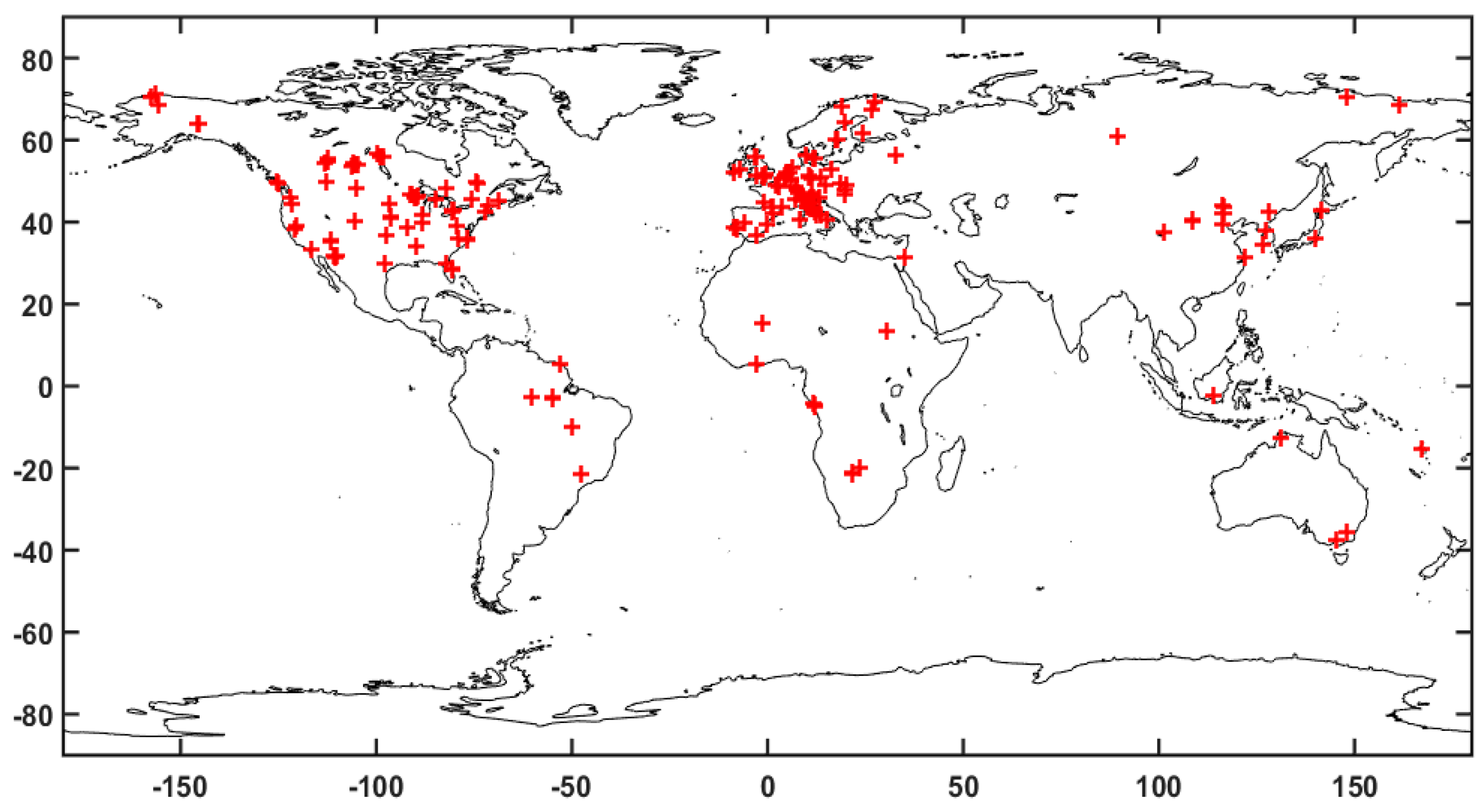
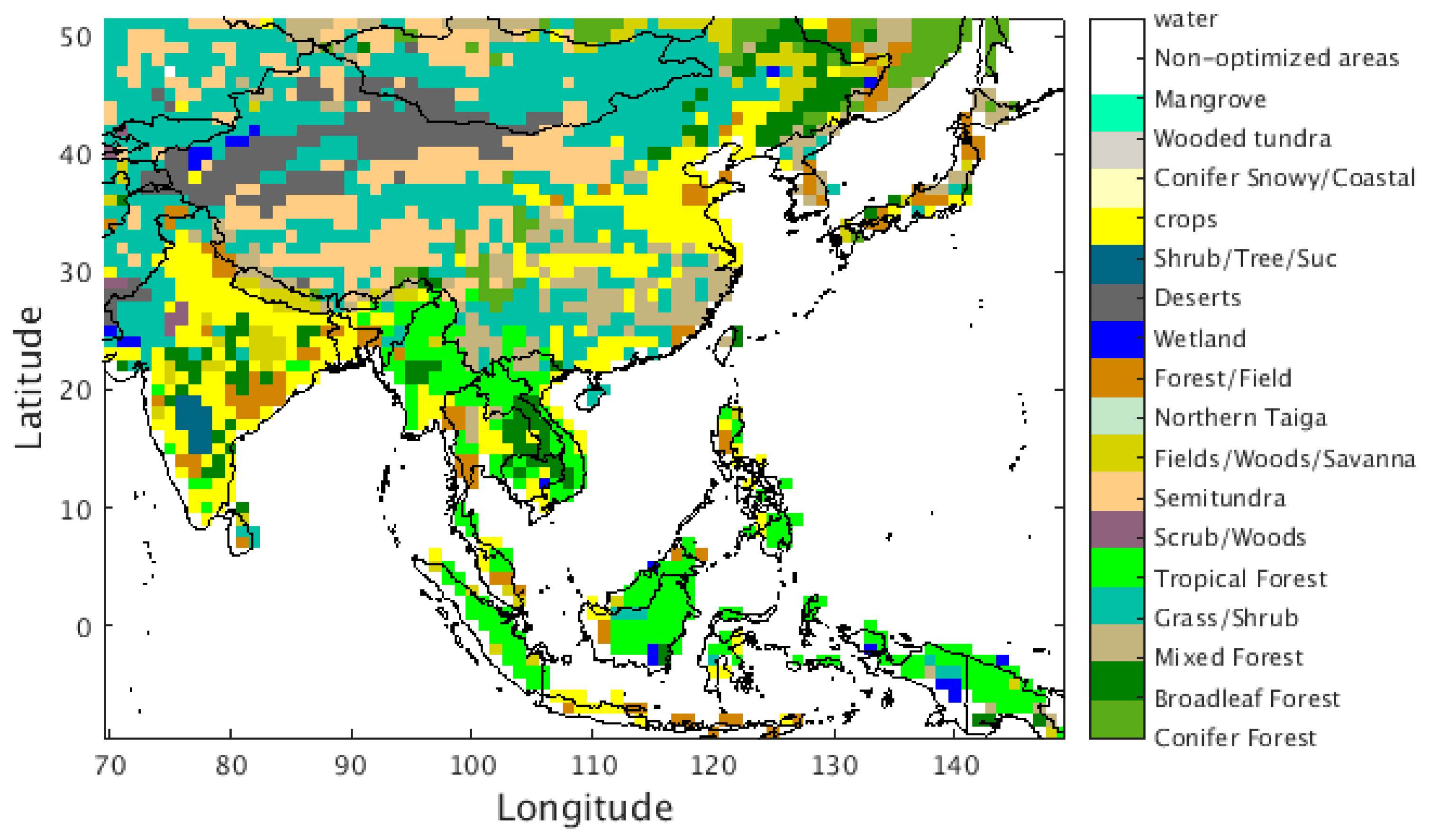



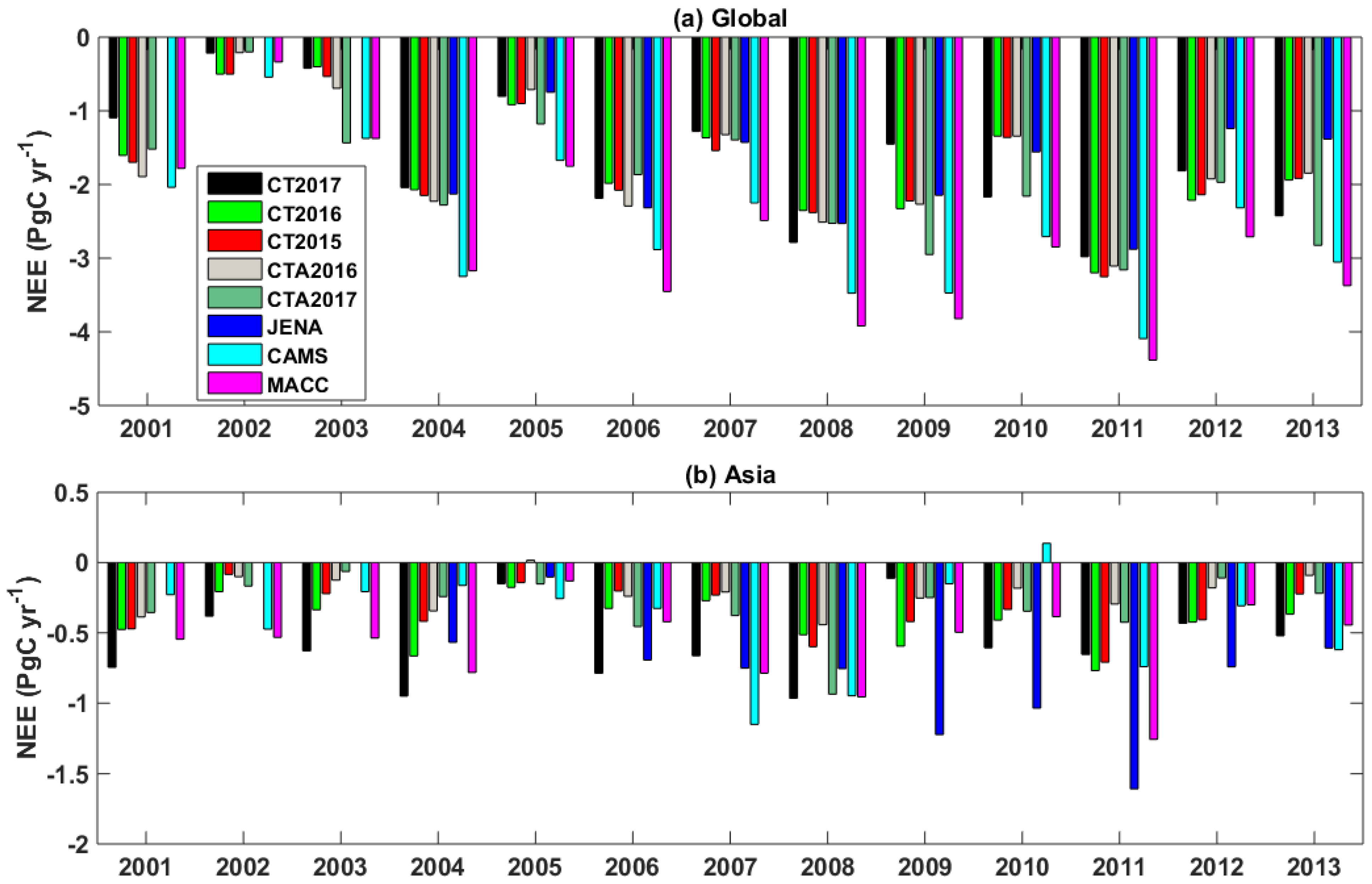



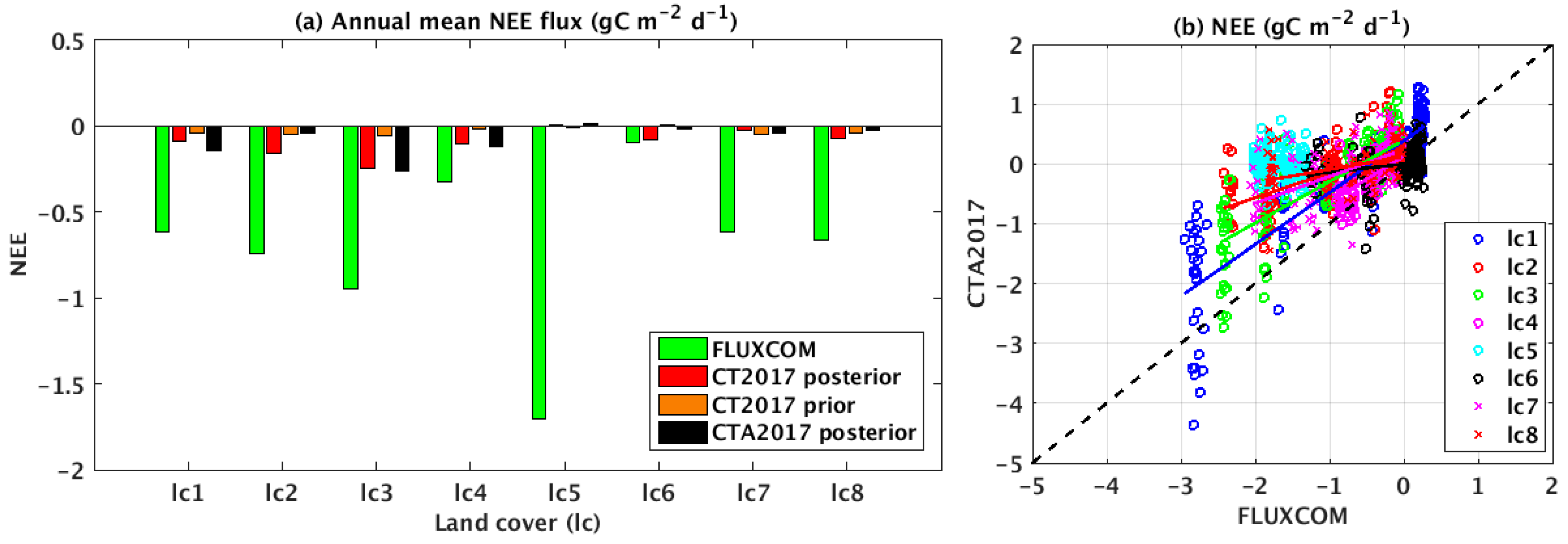


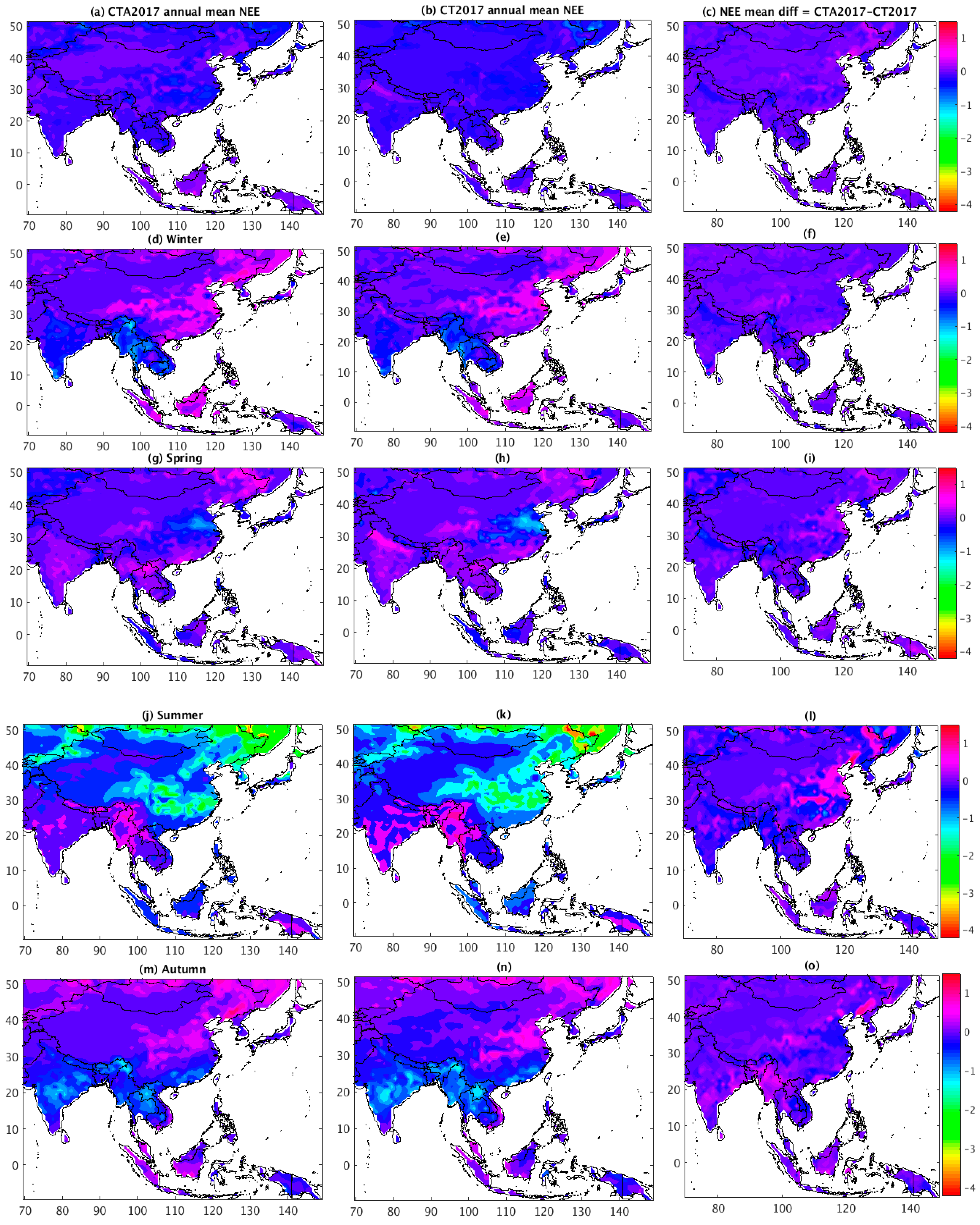
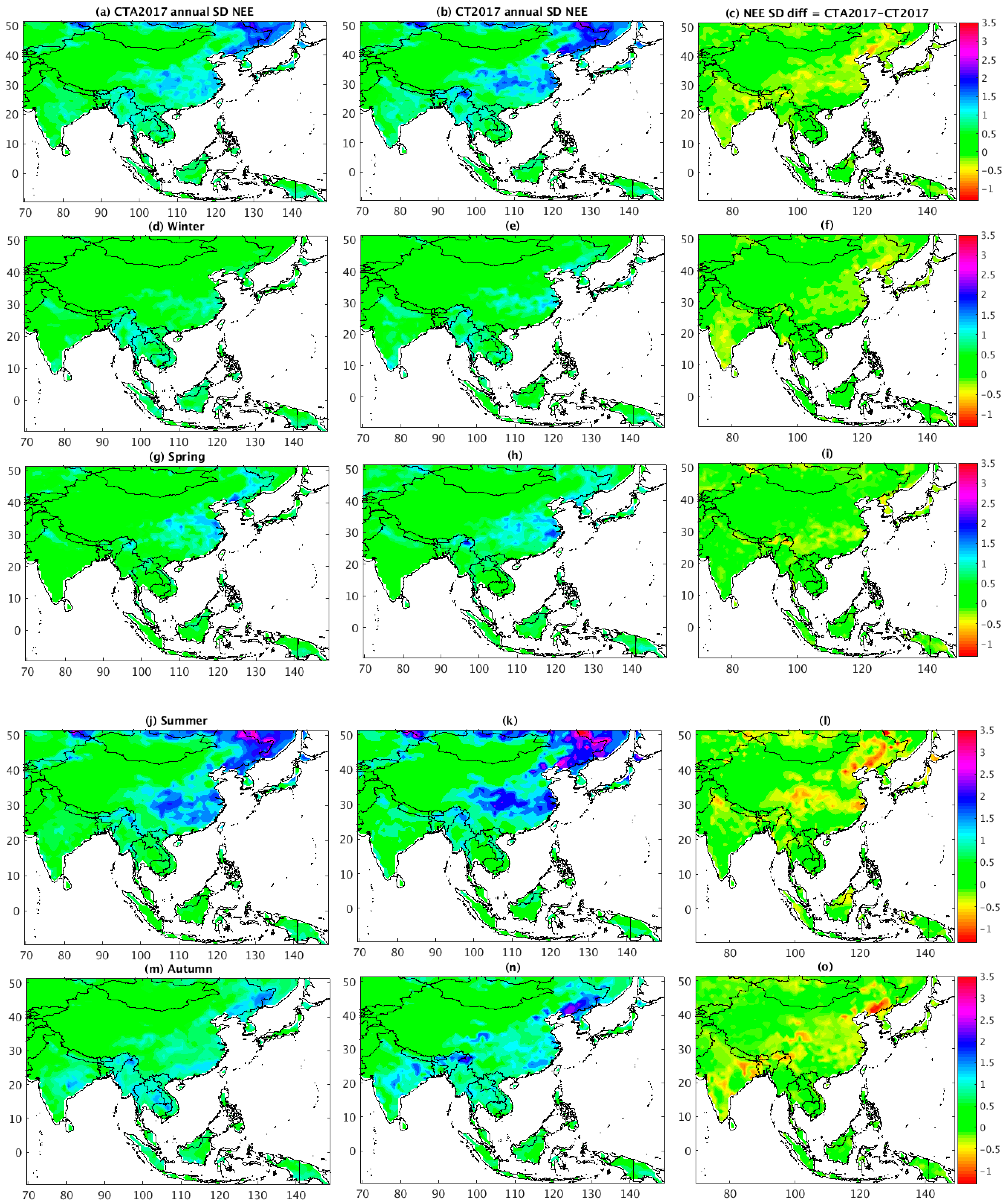
| Model | Ref. | Lat × lon | Fossil Fuel Priors | Biosphere and Fire Priors | Ocean Priors | Transport Model | No Vertical Layers | Meteorological Fields | Time Span | IAV Priors | IAV Wind |
|---|---|---|---|---|---|---|---|---|---|---|---|
| CT2017 | [15] | 2° × 3° global 1° × 1° over Asia | ODIAC2016 and Miller | CASA (GFED 4.1s & GFED_CMS) | Jacobson et al. [28] and Takahashi et al. [29] | TM5 | 25 | ERA-Interim | 2001–2013 | Yes | Yes |
| Jena (s04_v22) | [19] | 3.8298° × 5° | CDIAC | TM3 | 19 | NCEP | 2004–2013 | No | Yes | ||
| CAMS (v18r1) | [16,17] | 1.8947° × 3.75° | CDIAC/GCP2016 | ORCHIDEE (climatology) +GFEDv4 | Takahashi et al. [29] | LMDZ | 39 | ERA-Interim | 2001–2013 | Yes | Yes |
| MACC (v14r2) | [16,17] | 1.8947° × 3.75° | CDIAC/GCP2016 | ORCHIDEE (climatology) +GFEDv4 | Takahashi et al. [29] | LMDZ | 39 | ERA-Interim | 2001–2013 | Yes | Yes |
| Models/ Upscale Data | NEE Flux (PgC yr−1) | ||
|---|---|---|---|
| Asia Posterior | Prior | Global Posterior | |
| CTA2017 | −0.32 ± 0.22 | 0.25 ± 0.13 | –1.96 ± 0.82 |
| CTA2016 | −0.22 ± 0.13 | 0.25 ± 0.13 | –1.72 ± 0.83 |
| CT2017 | −0.58 ± 0.26 | –1.71 ± 0.80 | |
| CT2016 | −0.43 ± 0.18 | –1.71 ± 0.80 | |
| CT2015 | −0.34 ± 0.18 | –1.74 ± 0.78 | |
| CT2013B | 1.01 ± 1.50 | –2.36 ± 4.84 | |
| CAMS | −0.42 ± 0.36 | −0.08 ± 0.007 | –2.55 ± 0.98 |
| MACC-III | −0.58 ± 0.30 | −0.08 ± 0.007 | –2.72 ± 1.15 |
| Jena CarboScope | −0.81 ± 0.41 | –1.84 ± 0.66 | |
| FLUXCOM | −5.86 ± 0.03 | ||
| Thomson et al. [8] | −0.46 (Asia, 1996–2012) | ||
| Ichii et al. [35] | −0.90 (East Asia) | ||
| −0.94 (Southeast Asia) | |||
| Models/ Upscale Data | Prior (gCm−2d−1) | Posterior (gC m−2 d−1) | ||
|---|---|---|---|---|
| Winter | Summer | Winter | Summer | |
| CTA2017 | 0.18 ± 0.03 | −0.37 ± 0.08 | 0.11 ± 0.06 | −0.49 ± 0.13 |
| CT2017 | 0.18 ± 0.03 | −0.37 ± 0.08 | 0.10 ± 0.08 | −0.50 ± 0.16 |
| CAMS | 0.26 ± 0.10 | −0.37 ± 0.07 | 0.07 ± 0.04 | −0.36 ± 0.13 |
| MACC-III | 0.26 ± 0.10 | −0.37 ± 0.07 | 0.06 ± 0.06 | −0.36 ± 0.12 |
| Jena CarboScope | -- | 0.18 ± 0.07 | −0.64 ± 0.14 | |
| FLUXCOM | −0.24 ± 0.03 | −1.34 ± 0.12 | ||
| S.N | Land Cover Type | r1 | r2 | m1 | m2 |
|---|---|---|---|---|---|
| 1 | Conifer forest | 0.87 | 0.87 | 0.87 | 0.82 |
| 2 | Broadleaf forest | 0.67 | 0.68 | 0.42 | 0.50 |
| 3 | Mixed forest | 0.79 | 0.70 | 0.69 | 0.65 |
| 4 | Grass/shrub | 0.72 | 0.58 | 0.77 | 0.61 |
| 5 | Tropical forest | −0.15 | −0.12 * | −0.15 | −0.14 |
| 6 | Scrub/woods | 0.20 | 0.49 | 0.14 | 0.41 |
| 7 | Fields/woods/savanna | 0.60 | 0.52 | 0.45 | 0.45 |
| 8 | Croplands | 0.43 | 0.63 | 0.22 | 0.4 |
| SS.N | Land Cover Type | Annual Mean NEE Flux (gC m−2d−1) | |||
|---|---|---|---|---|---|
| CT2017 Priori | CTA2017 Posteriori | CT2017 Posteriori | FLUXCOM | ||
| 1 | Conifer forest | −0.04 ± 0.77 | −0.15 ± 1.13 | −0.10 ± 1.07 | −0.61 ± 1.13 |
| 2 | Broadleaf forest | −0.05 ± 0.27 | −0.04 ± 0.50 | −0.16 ± 0.60 | −0.74 ± 0.80 |
| 3 | Mixed forest | −0.05 ± 0.50 | −0.26 ± 0.76 | −0.25 ± 0.81 | −0.95 ± 0.87 |
| 4 | Grass/shrub | −0.02 ± 0.28 | −0.12 ± 0.31 | −0.10 ± 0.31 | −0.32 ± 0.29 |
| 5 | Tropical forest | −0.01 ± 0.19 | −0.02 ± 0.23 | −0.01 ± 0.27 | −1.71 ± 0.22 |
| 6 | Scrub/woods | 0.006 ± 0.13 | −0.02 ± 0.28 | −0.08 ± 0.35 | −0.10 ± 0.41 |
| 7 | Fields/woods/savanna | −0.05 ± 0.39 | −0.04 ± 0.44 | −0.02 ± 0.51 | −0.62 ± 0.60 |
| 8 | Croplands | −0.04 ± 0.16 | −0.02 ± 0.30 | −0.07 ± 0.38 | −0.67 ± 0.60 |
© 2020 by the authors. Licensee MDPI, Basel, Switzerland. This article is an open access article distributed under the terms and conditions of the Creative Commons Attribution (CC BY) license (http://creativecommons.org/licenses/by/4.0/).
Share and Cite
Kenea, S.T.; Labzovskii, L.D.; Goo, T.-Y.; Li, S.; Oh, Y.-S.; Byun, Y.-H. Comparison of Regional Simulation of Biospheric CO2 Flux from the Updated Version of CarbonTracker Asia with FLUXCOM and Other Inversions over Asia. Remote Sens. 2020, 12, 145. https://doi.org/10.3390/rs12010145
Kenea ST, Labzovskii LD, Goo T-Y, Li S, Oh Y-S, Byun Y-H. Comparison of Regional Simulation of Biospheric CO2 Flux from the Updated Version of CarbonTracker Asia with FLUXCOM and Other Inversions over Asia. Remote Sensing. 2020; 12(1):145. https://doi.org/10.3390/rs12010145
Chicago/Turabian StyleKenea, Samuel Takele, Lev D. Labzovskii, Tae-Young Goo, Shanlan Li, Young-Suk Oh, and Young-Hwa Byun. 2020. "Comparison of Regional Simulation of Biospheric CO2 Flux from the Updated Version of CarbonTracker Asia with FLUXCOM and Other Inversions over Asia" Remote Sensing 12, no. 1: 145. https://doi.org/10.3390/rs12010145
APA StyleKenea, S. T., Labzovskii, L. D., Goo, T. -Y., Li, S., Oh, Y. -S., & Byun, Y. -H. (2020). Comparison of Regional Simulation of Biospheric CO2 Flux from the Updated Version of CarbonTracker Asia with FLUXCOM and Other Inversions over Asia. Remote Sensing, 12(1), 145. https://doi.org/10.3390/rs12010145



